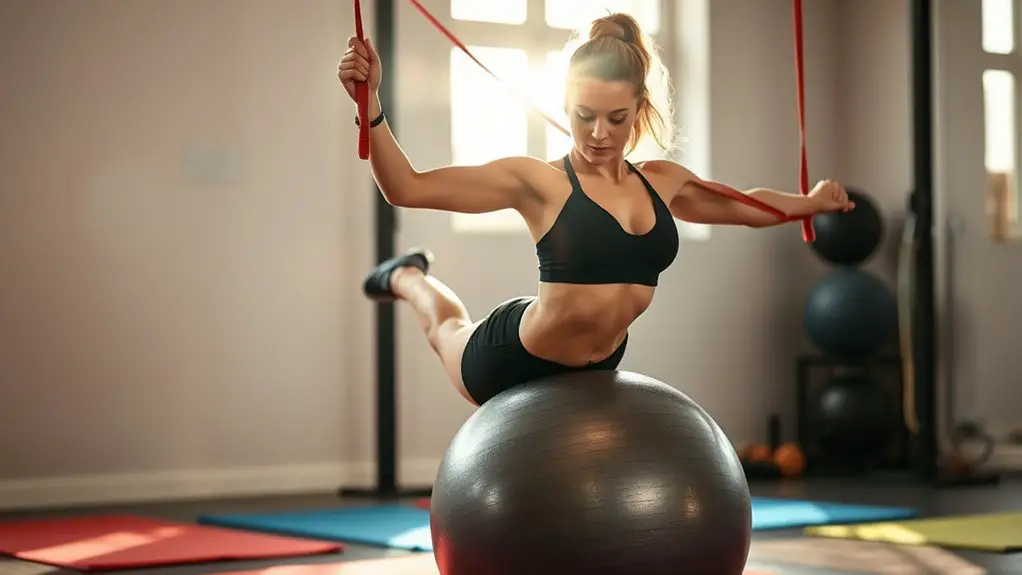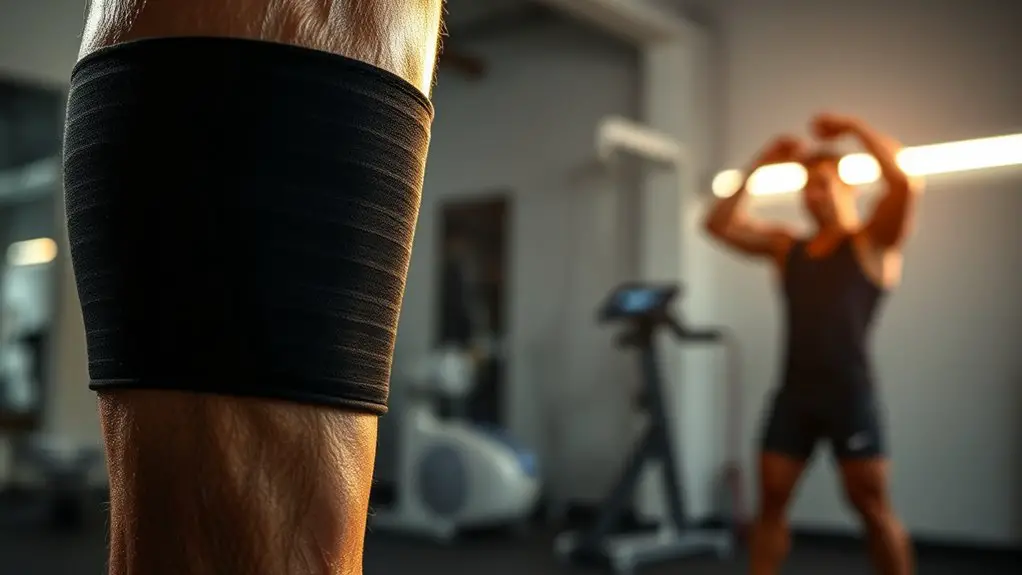To train stabilizer muscles for injury prevention, focus on exercises that enhance balance and stability. Incorporate planks, single-leg deadlifts, and lateral lunges into your routine. Use dynamic movements to engage your core, glutes, and other stabilizers. Aim for balance training techniques like single-leg stands or Bosu ball squats a few times a week. Prioritizing proper form is key. Learn how to create a balanced workout plan that targets these essential muscles for even better results.
Understanding Stabilizer Muscles and Their Importance
Stabilizer muscles play an essential role in maintaining your body's balance and support during movement, even if you don't always notice them at work. These muscles work behind the scenes, keeping your joints stable and allowing you to move freely. When you engage in activities like running, dancing, or even yoga, your stabilizers help prevent injuries by ensuring your body moves in harmony. By strengthening these muscles, you're not just enhancing your performance; you're also granting yourself the freedom to explore movement without fear. Think of them as your body's unsung heroes, providing the support you need to push your limits and enjoy life to the fullest. Embrace training these crucial muscles for a more liberated, active lifestyle.
Common Stabilizer Muscles in the Body
When it comes to stabilizer muscles, several key players contribute to your overall strength and balance. The core muscles, including the transverse abdominis and obliques, are essential for maintaining stability during movement. Your glutes, especially the gluteus medius, help stabilize your hips, while the rotator cuff muscles support shoulder stability. Don't forget about the muscles in your back, like the multifidus, which play a significant role in spinal stability. Even your ankles have stabilizers, such as the peroneals, that keep you steady during dynamic activities. By understanding these common stabilizer muscles, you can appreciate how they work together to enhance your freedom of movement and reduce the risk of injury. Emphasizing their training will empower you in all your physical pursuits.
Benefits of Training Stabilizer Muscles
Training stabilizer muscles offers numerous advantages that can greatly enhance your physical performance and overall well-being. By focusing on these often-overlooked muscles, you'll experience improved balance, coordination, and posture. This not only helps in everyday activities but also enhances your freedom to engage in various sports and fitness pursuits without the fear of injury. Additionally, stronger stabilizer muscles lead to more efficient movement patterns, allowing you to perform better in your workouts.
| Benefits | Description |
|---|---|
| Improved Balance | Helps maintain stability in dynamic movements |
| Enhanced Coordination | Supports better control during physical activities |
| Better Posture | Reduces strain on your body's structures |
| Injury Prevention | Protects against common injuries |
Key Exercises for Strengthening Stabilizer Muscles
Focusing on strengthening your stabilizer muscles can greatly enhance your overall performance, and incorporating specific exercises into your routine is the way to go. These exercises target those often-overlooked muscles, ensuring you move freely and confidently.
- Plank Variations: Engaging your core while maintaining stability helps improve your balance and strength.
- Single-Leg Deadlifts: This exercise challenges your balance and targets your stabilizers, promoting better coordination.
- Side Lunges: By shifting your weight side to side, you'll activate your inner and outer thigh muscles, enhancing stability.
Incorporating Balance Training Into Your Routine
Incorporating balance training into your routine can greatly improve your stabilizer muscles and overall athletic performance. Balance exercises not only enhance your strength but also your agility and coordination, giving you the freedom to move more efficiently. Here's a quick reference table to help you get started:
| Exercise | Duration | Frequency |
|---|---|---|
| Single Leg Stand | 30 sec | 3 times/week |
| Bosu Ball Squats | 10 reps | 2 times/week |
| Lateral Lunges | 10 reps | 3 times/week |
| Stability Ball Pass | 10 reps | 2 times/week |
| Balance Board | 5 min | 4 times/week |
Try these exercises, and you'll see how balance training can reveal new levels of performance and injury prevention in your activities.
The Role of Core Stability in Injury Prevention
While many athletes concentrate on building strength and endurance, neglecting core stability can lead to increased injury risk. A strong core acts as a foundation for your entire body, allowing you to move freely and efficiently. When your core muscles are engaged, you're less likely to compensate with other muscle groups, which can cause strain and injury.
- Enhances overall balance and coordination
- Supports proper posture during activities
- Reduces the risk of lower back pain
Using Resistance Bands for Stabilizer Training
A <strong>strong core isn't just about preventing injuries; it also plays a key role in your stabilizer training. Using resistance bands can effectively enhance your core's stability. These bands add resistance while allowing for a full range of motion, making your workouts dynamic and engaging. You can easily adjust the tension to match your strength level, ensuring a tailored experience that promotes growth. Incorporating exercises like banded squats or rotational movements challenges your stabilizer muscles, enhancing your overall strength and balance. Plus, they're portable, giving you the freedom to train anywhere—whether at home or in a park. So grab those bands, and start incorporating them into your routine for a fun way to boost your stabilizer training!
Tips for Proper Form and Technique
To maximize the effectiveness of your stabilizer training, focusing on proper form and technique is essential. You want to guarantee that each movement targets the right muscles while minimizing injury risk. Here are some tips to help you maintain proper form:
- Engage your core: Keep your abdominal muscles tight to provide stability and support during exercises.
- Control your movements: Avoid rushing through reps; slow, deliberate motions enhance muscle engagement and control.
- Maintain alignment: Ensure your joints align correctly throughout the movement to prevent strain.
Creating a Balanced Workout Plan for Stabilizer Muscle Training
Creating a balanced workout plan for stabilizer muscle training is essential, as it guarantees all muscle groups are engaged effectively. Start by incorporating exercises that target your core, hips, and shoulders, ensuring you're not neglecting any key areas. Think about mixing in multi-directional movements like lunges, planks, and resistance band work. Aim for at least three sessions a week, allowing your body to recover between workouts. Don't forget to include flexibility and mobility work to enhance your range of motion. Listen to your body; if something feels off, adjust accordingly. By focusing on balance and variety, you'll build a solid foundation that keeps you free from injury while enjoying your favorite activities. Embrace your journey to strength and stability!
Frequently Asked Questions
How Often Should I Train My Stabilizer Muscles Each Week?
You should train your stabilizer muscles about two to three times a week. Consistency's key, but listen to your body. It's all about finding that balance, allowing yourself to recover and grow stronger.
Can Stabilizer Muscle Training Help With Sports Performance?
Sure, ignoring stabilizer muscles is a great way to boost your sports performance! But if you actually want to excel, training them can enhance your stability, strength, and agility—key elements for any athlete's success.
What Are the Signs of Overtraining Stabilizer Muscles?
If you're overtraining stabilizer muscles, you might feel persistent soreness, fatigue, or a decrease in performance. You may also notice joint pain or a lack of motivation. Listening to your body is essential for recovery.
Are There Age-Specific Considerations for Stabilizer Muscle Training?
As the sun sets on your fitness journey, remember that age shapes your body's needs. Tailor your stabilizer muscle training to your stage of life, ensuring freedom in movement and joy in every step you take.
How Can I Track My Progress in Stabilizer Muscle Strength?
To track your progress in stabilizer muscle strength, keep a workout journal, note your exercises, reps, and how you feel. Regularly check your form and stability; you're building awareness and improvement over time. Enjoy the journey!




